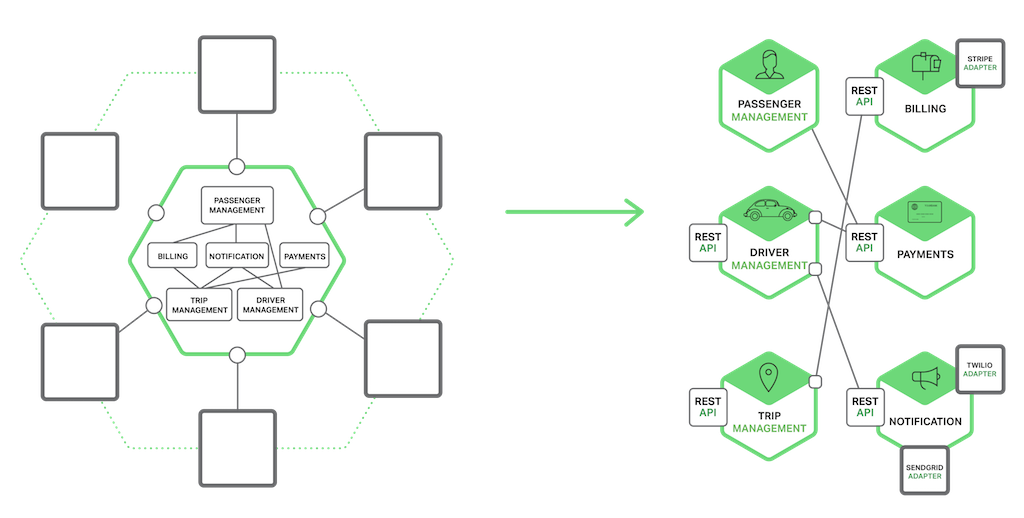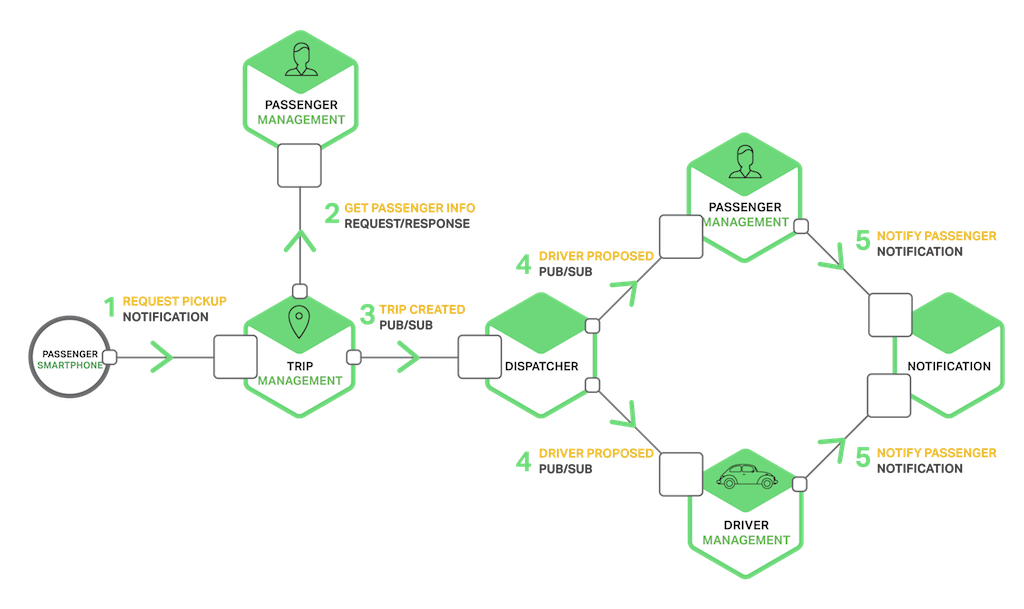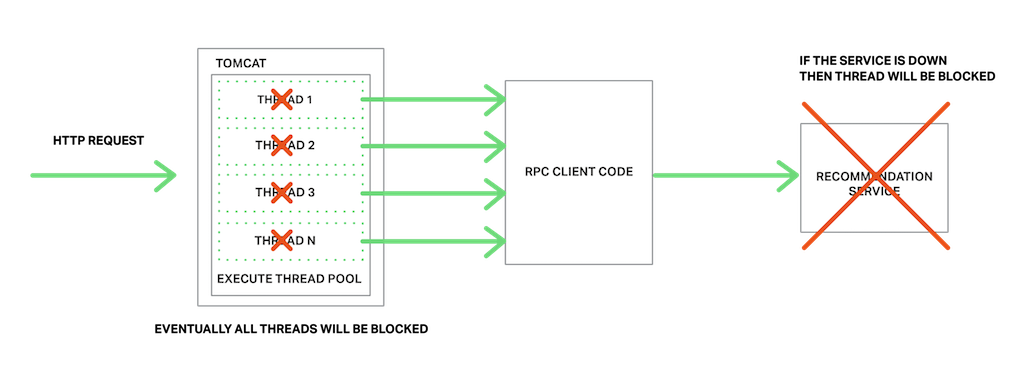Introduction
In a monolithic application, components invoke one another via language‑level method or function calls. In contrast, a microservices‑based application is a distributed system running on multiple machines. Each service instance is typically a process. Consequently, as the following diagram shows, services must interact using an inter‑process communication (IPC) mechanism.

Interaction Styles
When selecting an IPC mechanism for a service, it is useful to think first about how services interact. There are a variety of client⇔service interaction styles. They can be categorized along two dimensions. The first dimension is whether the interaction is one‑to‑one or one‑to‑many:
- One‑to‑one – Each client request is processed by exactly one service instance.
- One‑to‑many – Each request is processed by multiple service instances.
The second dimension is whether the interaction is synchronous or asynchronous:
- Synchronous – The client expects a timely response from the service and might even block while it waits.
- Asynchronous – The client doesn’t block while waiting for a response, and the response, if any, isn’t necessarily sent immediately.
The following table shows the various interaction styles.
| One-to-One | One-to-Many | |
|---|---|---|
| Synchronous | Request/response | — |
| Asynchronous | Notification | Publish/subscribe |
| Request/async response | Publish/async responses |
There are the following kinds of one‑to‑one interactions:
- Request/response – A client makes a request to a service and waits for a response. The client expects the response to arrive in a timely fashion. In a thread‑based application, the thread that makes the request might even block while waiting.
- Notification (a.k.a. a one‑way request) – A client sends a request to a service but no reply is expected or sent.
- Request/async response – A client sends a request to a service, which replies asynchronously. The client does not block while waiting and is designed with the assumption that the response might not arrive for a while.
There are the following kinds of one‑to‑many interactions:
- Publish/subscribe – A client publishes a notification message, which is consumed by zero or more interested services.
- Publish/async responses – A client publishes a request message, and then waits a certain amount of time for responses from interested services.
Each service typically uses a combination of these interaction styles. For some services, a single IPC mechanism is sufficient. Other services might need to use a combination of IPC mechanisms. The following diagram shows how services in a taxi-hailing application might interact when the user requests a trip.
The services use a combination of notifications, request/response, and publish/subscribe. For example, the passenger’s smartphone sends a notification to the Trip Management service to request a pickup. The Trip Management service verifies that the passenger’s account is active by using request/response to invoke the Passenger Service. The Trip Management service then creates the trip and uses publish/subscribe to notify other services including the Dispatcher, which locates an available driver.
Now that we have looked at interaction styles, let’s take a look at how to define APIs.
Defining APIs
A service’s API is a contract between the service and its clients. Regardless of your choice of IPC mechanism, it’s important to precisely define a service’s API using some kind of interface definition language (IDL). There are even good arguments for using an API‑first approach to defining services. You begin the development of a service by writing the interface definition and reviewing it with the client developers. It is only after iterating on the API definition that you implement the service. Doing this design up front increases your chances of building a service that meets the needs of its clients.
As you will see later in this article, the nature of the API definition depends on which IPC mechanism you are using. If you are using messaging, the API consists of the message channels and the message types. If you are using HTTP, the API consists of the URLs and the request and response formats. Later on we will describe some IDLs in more detail.
Evolving APIs
A service’s API invariably changes over time. In a monolithic application it is usually straightforward to change the API and update all the callers. In a microservices‑based application it is a lot more difficult, even if all of the consumers of your API are other services in the same application. You usually cannot force all clients to upgrade in lockstep with the service. Also, you will probably incrementally deploy new versions of a service such that both old and new versions of a service will be running simultaneously. It is important to have a strategy for dealing with these issues.
How you handle an API change depends on the size of the change. Some changes are minor and backward compatible with the previous version. You might, for example, add attributes to requests or responses. It makes sense to design clients and services so that they observe the robustness principle. Clients that use an older API should continue to work with the new version of the service. The service provides default values for the missing request attributes and the clients ignore any extra response attributes. It is important to use an IPC mechanism and a messaging format that enable you to easily evolve your APIs..
Sometimes, however, you must make major, incompatible changes to an API. Since you can’t force clients to upgrade immediately, a service must support older versions of the API for some period of time. If you are using an HTTP‑based mechanism such as REST, one approach is to embed the version number in the URL. Each service instance might handle multiple versions simultaneously. Alternatively, you could deploy different instances that each handle a particular version.
Handling Partial Failure
As mentioned in the previous article about the API Gateway, in a distributed system there is the ever‑present risk of partial failure. Since clients and services are separate processes, a service might not be able to respond in a timely way to a client’s request. A service might be down because of a failure or for maintenance. Or the service might be overloaded and responding extremely slowly to requests.
Consider, for example, the Product details scenario from that article. Let’s imagine that the Recommendation Service is unresponsive. A naive implementation of a client might block indefinitely waiting for a response. Not only would that result in a poor user experience, but in many applications it would consume a precious resource such as a thread. Eventually the runtime would run out of threads and become unresponsive as shown in the following figure.
To prevent this problem, it is essential that you design your services to handle partial failures.
A good to approach to follow is the one described by Netflix. The strategies for dealing with partial failures include:
- Network timeouts – Never block indefinitely and always use timeouts when waiting for a response. Using timeouts ensures that resources are never tied up indefinitely.
- Limiting the number of outstanding requests – Impose an upper bound on the number of outstanding requests that a client can have with a particular service. If the limit has been reached, it is probably pointless to make additional requests, and those attempts need to fail immediately.
- Circuit breaker pattern – Track the number of successful and failed requests. If the error rate exceeds a configured threshold, trip the circuit breaker so that further attempts fail immediately. If a large number of requests are failing, that suggests the service is unavailable and that sending requests is pointless. After a timeout period, the client should try again and, if successful, close the circuit breaker.
- Provide fallbacks – Perform fallback logic when a request fails. For example, return cached data or a default value such as empty set of recommendations.
Netflix Hystrix is an open source library that implements these and other patterns. If you are using the JVM you should definitely consider using Hystrix. And, if you are running in a non‑JVM environment you should use an equivalent library.
IPC Technologies
There are lots of different IPC technologies to choose from. Services can use synchronous request/response‑based communication mechanisms such as HTTP‑based REST or Thrift. Alternatively, they can use asynchronous, message‑based communication mechanisms such as AMQP or STOMP. There are also a variety of different message formats. Services can use human readable, text‑based formats such as JSON or XML. Alternatively, they can use a binary format (which is more efficient) such as Avro or Protocol Buffers.

